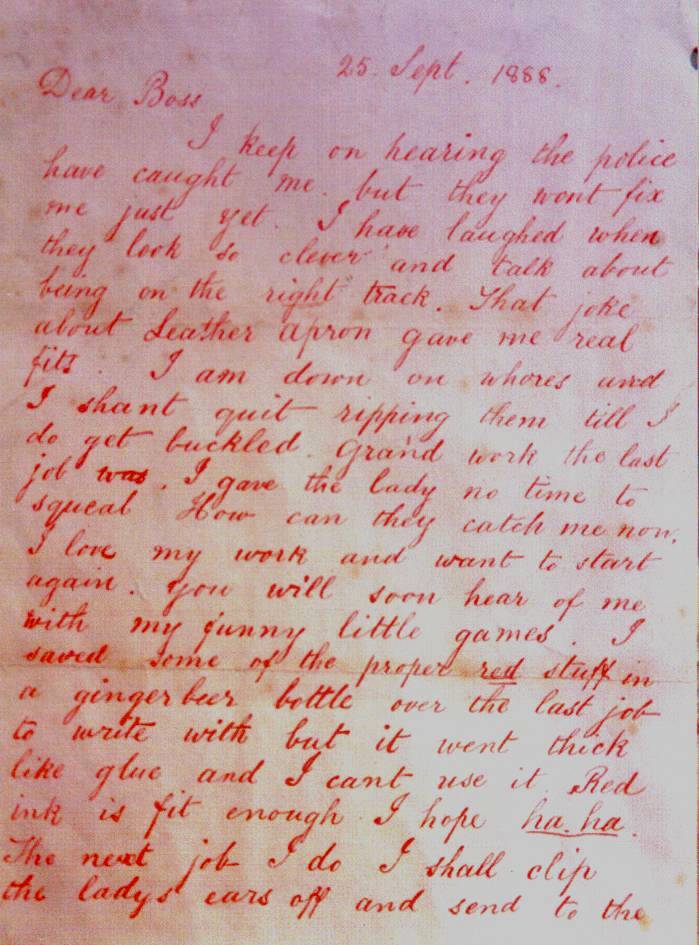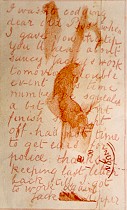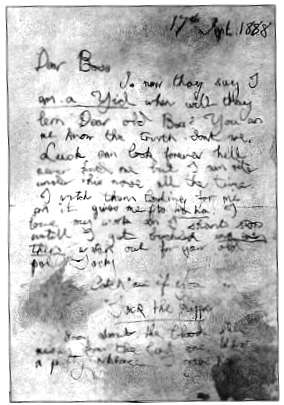
Jack the Ripper is an alias given to an unidentified serial killer active in the largely impoverished Whitechapel area and adjacent districts of London, England in the autumn of 1888. The name is taken from a letter sent to the Central News Agency by someone claiming to be the murderer.
The victims were women allegedly earning income as prostitutes. The murders were perpetrated in public or semi-public places at night or towards the early morning. The victim's throat was cut, after which the body was mutilated. Theories suggest the victims were first strangled in order to silence them, which also explained the reported lack of blood at the crime scenes. The removal of internal organs from three of the victims led some officials at the time of the murders to propose that the killer possessed anatomical or surgical knowledge.
Newspapers, whose circulation had been growing during this era, bestowed widespread and enduring notoriety on the killer owing to the savagery of the attacks and the failure of the police in their attempts to capture the murderer, sometimes missing him at the crime scenes by mere minutes.
Due to the lack of a confirmed identity for the killer, the legends surrounding the murders have become a combination of genuine historical research, folklore and exploitation. Over the years, many authors, historians, and amateur detectives have proposed theories regarding the identity (or identities) of the killer and his victims.
The Victims

It is unclear just how many women the Ripper killed. It is generally accepted that he killed five, though some have written that he murdered only four while others say seven or more. The public, press, and even many junior police officers believed that the Ripper was responsible for nine slayings. The five that are generally accepted as the work of the Ripper are:
Mary Ann (Polly) Nichols, murdered Friday, August 31, 1888.
Annie Chapman, murdered Saturday, September 8, 1888.
Elizabeth Stride, murdered Sunday, September 30, 1888.
Catharine Eddowes, also murdered that same date.
Mary Jane (Marie Jeanette) Kelly, murdered Friday, November 9, 1888.
Besides these five there are good reasons to believe that the first victim was really
Martha Tabram who was murdered Tuesday, August 7, 1888, and there are important considerations for questioning whether Stride was a Ripper victim.
As to the actual number of women that the Ripper killed, Philip Sugden wrote in his excellent book, The Complete History of Jack the Ripper, "There is no simple answer.
In a sentence: at least four, probably six, just possibly eight." All five of these listed plus Tabram were prostitutes and were killed between early August and early November 1888. All but Tabram and Kelly were killed outdoors and there is no evidence to suggest that any of them knew each other. They varied in both age and appearance. Most were drunk or thought to be drunk at the time they were killed.
The letters


(Transcription)
Dear Boss,I keep on hearing the police have caught me but they wont fix me just yet. I have laughed when they look so clever and talk about being on the right track. That joke about Leather Apron gave me real fits. I am down on whores and I shant quit ripping them till I do get buckled. Grand work the last job was. I gave the lady no time to squeal. How can they catch me now. I love my work and want to start again. You will soon hear of me with my funny little games. I saved some of the proper red stuff in a ginger beer bottle over the last job to write with but it went thick like glue and I cant use it. Red ink is fit enough I hope ha. ha. The next job I do I shall clip the ladys ears off and send to the police officers just for jolly wouldn't you. Keep this letter back till I do a bit more work, then give it out straight. My knife's so nice and sharp I want to get to work right away if I get a chance. Good Luck.
Yours trulyJack the Ripper
Dont mind me giving the trade name
PS Wasnt good enough to post this before I got all the red ink off my hands curse it No luck yet. They say I'm a doctor now. ha ha

(Transcription)
I was not codding dear old Boss when I gave you the tip, you'll hear about Saucy Jacky's work tomorrow double event this time number one squealed a bit couldn't finish straight off. ha not the time to get ears for police. thanks for keeping last letter back till I got to work again.
Jack the Ripper

(Transcription)
From hell.Mr Lusk,SorI send you half the Kidne I took from one woman and prasarved it for you tother piece I fried and ate it was very nise. I may send you the bloody knif that took it out if you only wate a whil longer
signed Catch me when you can Mishter Lusk

(Transcription)
17th Sept 1888
Dear Boss
So now they say I am a Yid when will they lern Dear old Boss! You an me know the truth dont we. Lusk can look forever hell never find me but I am rite under his nose all the time. I watch them looking for me an it gives me fits ha ha I love my work an I shant stop until I get buckled and even then watch out for your old pal Jacky.
Catch me if you Can Jack the Ripper
Sorry about the blood still messy from the last one. What a pretty necklace I gave her.

The Juwes are not the men That Will be Blamed for nothing
The major suspect

One of the most intriguing of these fragments is the assertion by Sir Robert Anderson, head of the Criminal Investigation Division of the London Metropolitan Police in 1888, that he knew the identity of Jack the Ripper. In an article published in Blackwood's Magazine in 1910, Anderson claimed that the Police had in fact solved the case, but had declined to publicize the fact because, as he says, "no public benefit would result from such a course, and the traditions of my old department would suffer". Anderson made similar assertions in other published sources, most notably in his book "The Lighter Side of My Official Life", also published in 1910. While Anderson never named the suspect in question, he did give a general description of him: the perpetrator was, according to Anderson, a low-class Polish Jew who was "caged in an asylum", and who was "at once identified" by "the only person who had ever had a good view of the murderer." Anderson also tells us that the killer was "a sexual maniac of a virulent type" who lived "in the immediate vicinity of the scenes of the murders," and "whose utterly unmentionable vices reduced him to a lower level than that of the brute".
In 1959, the name of Anderson's Polish Jew suspect was finally revealed to be 'Kosminski', after the discovery of a copy of an internal police memo written in 1894 by Anderson's second in command, Melville Macnaghten. The memo lists as a suspect: "Kosminski, a Polish Jew, who lived in the very heart of the district where the murders were committed. He had become insane owing to many years indulgence in solitary vices. He had a great hatred of women, with strong homicidal tendencies."
Further indication that Anderson's suspect's name was Kosminski was established with the discovery of handwritten notes written by ex-superintendent Donald Sutherland Swanson in the margin and end-paper of his personal copy of Anderson's memoirs. Fleshing out the details of the witness identification referred to by Anderson, Swanson writes: "the suspect had been identified at the Seaside Home where he had been sent by us with difficulty in order to subject him to identification, and he knew he was identified. On suspect's return to his brother's house in Whitechapel he was watched by police (City CID) by day and night. In a very short time the suspect with his hands tied behind his back, he was sent to Stepney Workhouse and then to Colney Hatch and died shortly afterwards - Kosminski was the suspect".
This article proposes a re-examination of the suspect Aaron Kosminski. We will take a closer look at what is known about the Polish Jew hairdresser: his background of growing up in an environment characterized by poverty, oppression, and exposure to violence; his public display of masturbation; his diagnosis suggesting schizophrenia - that he hears voices which guide his every movement. We know, for example, that he threatened his sister with a knife. Melville Macnaghten claimed to have evidence that Kosminski hated women, and that he had homicidal tendencies. And there were other "circs", according to Macnaghten, that made him a strong suspect - evidence that has apparently been lost. Aaron was the right age basically, and he was said to have "strongly resembled the individual seen by the City PC near Mitre Square". He was identified by a witness. His presumed residence in 1888 was in the geographic center of the murders.











